The Fall Issue 2023 Writing from the North Shore
 Letter from the Editor
Letter from the Editor
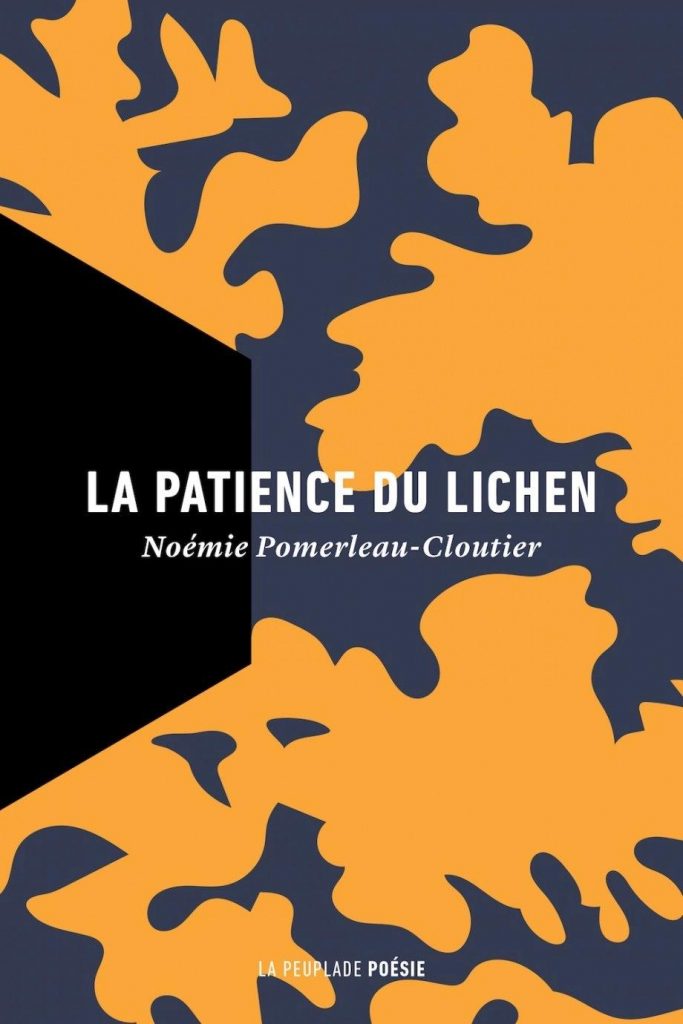 The Patience of Lichen
The Patience of Lichen
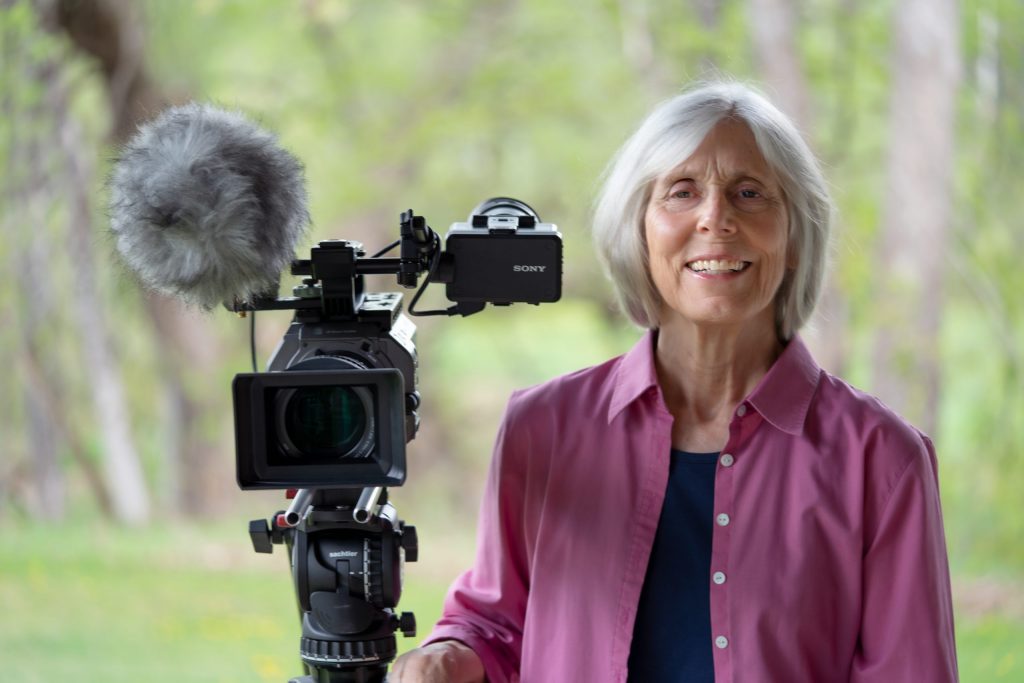 The Reunion At Salmon Bay
The Reunion At Salmon Bay
 Seaglass
Seaglass
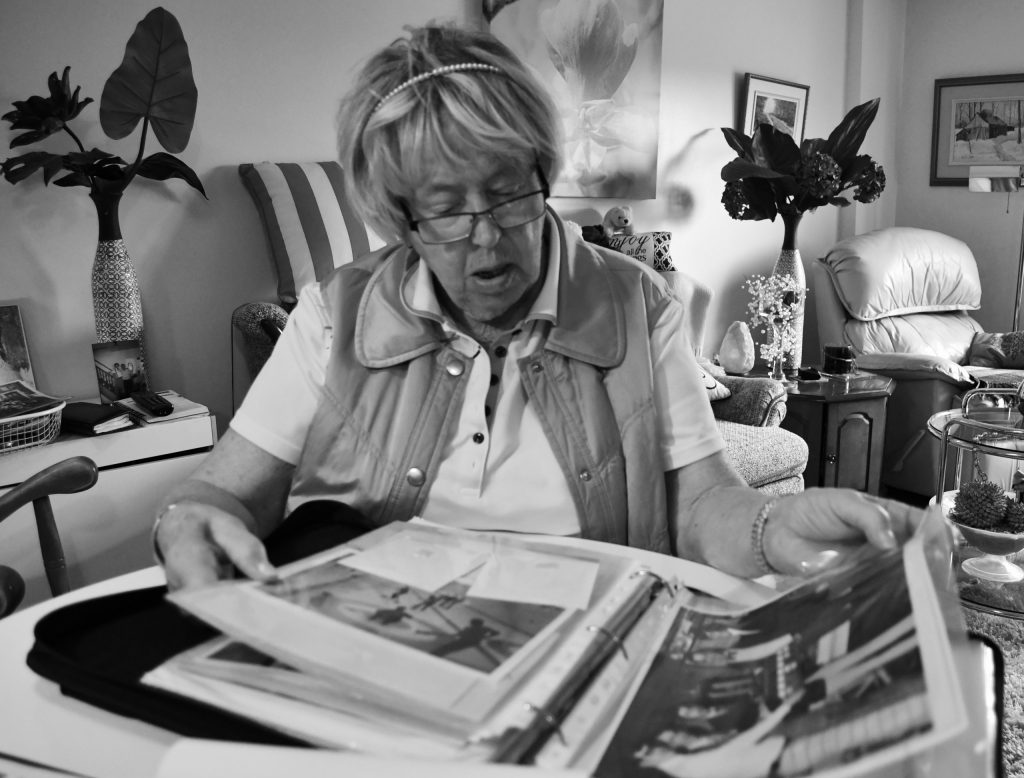 North Shore Heritage Capsules: Insights and Reflections
North Shore Heritage Capsules: Insights and Reflections
 how does one find a way to come back so many times?
how does one find a way to come back so many times?
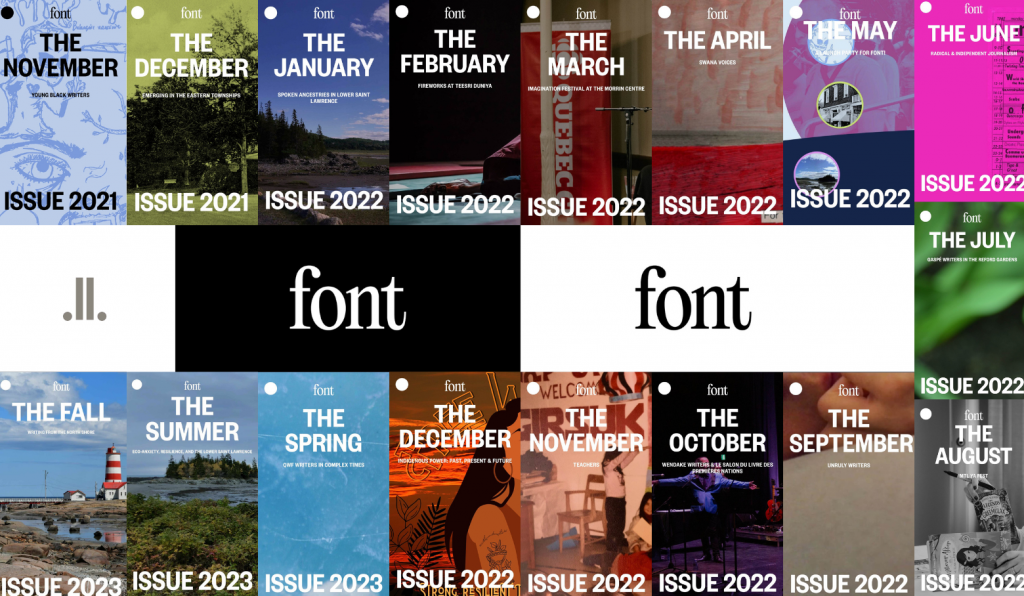 The Story of Font
The Story of Font
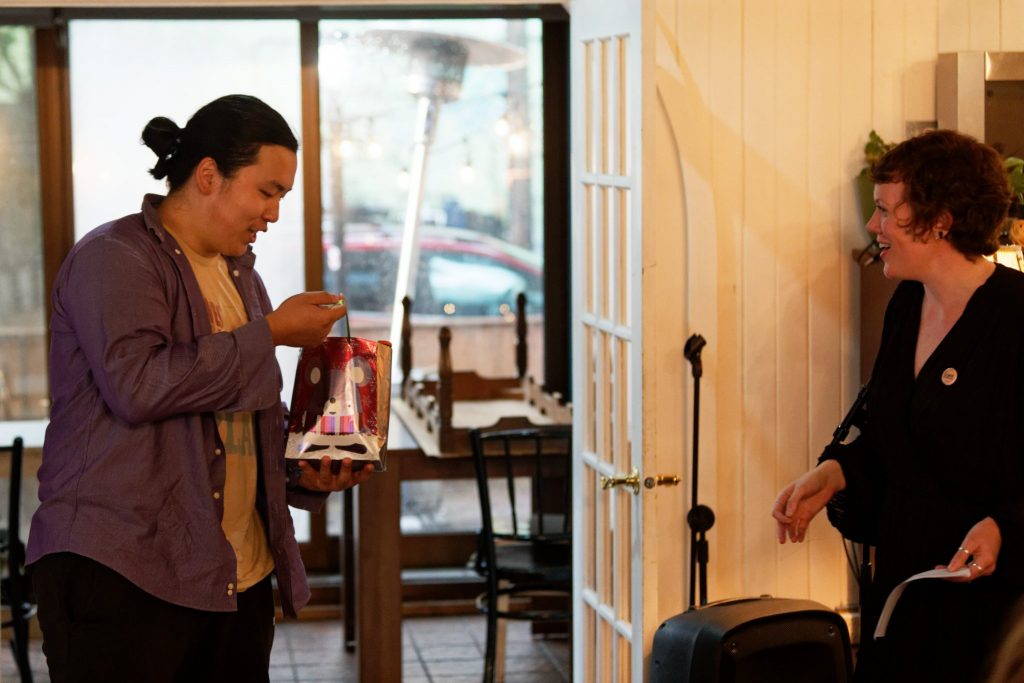 Font staff reflect
Font staff reflect
Well, here it is – the seventeenth and last edition of Font. Just over two years from our first Issue – Young Black Writers – and we are incredibly proud of what has been published in this time. You can read more about the story of how Font came to be from LLP/Font publisher Linda Leith, as well as some final reflections from the Font staff.
But let’s celebrate our final issue: writing from the North Shore of Quebec! This is a personal treat for me. Although I’ve only made it as far the River Mish-te-shipu— ‘great river’ in Innu-aimun, the language of the Innu, Indigenous people of this region—I adore the salt and wildness of the landscape. Until I can explore further, I’m delighted to let these Coasters tell us about the life in Blanc-Sablon, Harrington Harbour, Baie-Comeau and more. Jake Letto takes us right up to the Quebec-Labrador border, with its associated time-related complexities, while Caitlin Jewelle Rowsell gives us an unforgettable metaphor for the resilience of those who live on the edge. Stephen Kohner’s reflection on the Heritage Capsule project opens up the stories of seniors and community since the 1950s, and Louise Abbott’s Reunion at Salmon Bay is a beautiful reflection on her enduring ties to the area. Finally, Baie-Comeau-born poet Noémie Pomerleau-Cloutier’s work from her award winning collection La Patience du Lichen (La Peuplade, 2021) appears in a new translation by Jeffrey K. Butt, and also in an original poem in English.
We hope, as always, that you enjoy.
Between two worlds: living on the border
The Lower North Shore, situated in the easternmost part of Quebec, is a beautiful, vast territory that encompasses fifteen communities, including two Innu villages. From summer to winter, there are many activities to do and sights to see: I love watching the icebergs and whales every summer. It has a rich history of over 9,000 years and, best of all, holds some of the most heart-warming and nicest people on earth. Affectionately referred to as “the Coast,” the region is a hidden gem.
Despite only having a combined population of approximately five thousand, each town has its own unique character with different accents, dialects, and traditions. There is a sense of unity throughout the 375 kilometre stretch of coastline. There are many elements to explore within each community, from the intriguing stories to the numerous local celebrations, tournaments, and events that happen regularly. I decided to touch upon one of the favourite aspects of my home: life on the border.
Now when I say border, you may picture a big line or wall splitting two different states with a strict control on what comes in and out. But the Quebec-Labrador border is nothing but a line on a map, a parking lot, and a big sign indicating the province you are entering. One thing I find very special is that villages near this border are close with one another, not only in distance but also in community relationships. We are like one big family. People on one side of the border rely on goods and services from the other side, and vice versa.
I live on the Labrador side in L’Anse-au-Clair. I go to school on the Quebec side in Lourdes-de-Blanc-Sablon. I work in the summer on the Labrador side. I play hockey on the Quebec side. I hang out with my friends on both sides of the border and I have family on both sides. In fact, on any given day of the week, I cross the border at least four times.
Sports are also an important aspect of life on the Coast with hockey, volleyball, and badminton tournaments held regularly. There can be a hockey tournament in Lourdes-de-Blanc-Sablon, where teams from all over the Lower North Shore and even the Labrador Straits will come to play. A month later, there might be another hockey tournament in neighbouring L’Anse-au-Loup, Labrador. Teams from the Lower North Shore will come to that tournament as well by snowmobile, boat, or plane. This is the perfect time to see friends from ‘up’ the Coast (communities to the west of the border), who are not accessible by road.
One thing that is oddly different about this corner of the world is the time zone change. I’ve had many tourists and other individuals ask me about the time here, as it can be quite confusing. On the Labrador side, residents go by Newfoundland Time. On the Quebec side, residents follow Blanc-Sablon time (time zone of the Lower North Shore). Pretty simple, right? That’s just the beginning.
The “Coast” does not observe daylight saving, but Newfoundland does. So, in the winter and fall months, Newfoundland is ahead by thirty minutes, which is not too bad. But in the spring, the difference changes to one hour and thirty minutes. If you cross the border to drive from Blanc-Sablon to L’Anse-au-Clair (just minutes apart), you can time travel ahead thirty or ninety minutes, depending on the time of year.
This is especially useful for New Year’s Eve. You could start in L’Anse-au-Clair and celebrate as the clock strikes midnight. Then you can drive up the road to Blanc-Sablon and celebrate the same festivities, thirty minutes later. This unique time zone difference allows you to then go “Back To The Future” in L’Anse-au-Clair to sleep.
In the spring, the time difference is so big that I wake up at 8:15 in Labrador, take my shower, eat my breakfast, get ready, go on the bus and travel to school. By the time the first class starts, the clock still reads 8:15. It could be my superpowers that freeze time, or it could just be another aspect of our daily life on the Coast.
There are endless reasons to love this region, including its breathtaking scenery, the kindness of its people, and both its cultural and historical significance that date back nine millennia. For all of this and more, the Coast is a very important place for me. After university, I hope to build a life ‘back home,’ somewhere near the border, and share the love for this land with my future kids. I will forever be proud to say that I’m a Coaster.
The Patience of Lichen


I know not
what I’ve come here to find
I’ve never known how to stay in one place
the ground always gives way
the ends of the world
have become my escape
perhaps
a patch of moss
a place to settle
amongst the voices
of the land
perhaps
an anchorage
for my plexus
like them I wish I could
stay
**
here
the winds speak
the clouds keep secrets
the tides play tricks
the nets bring food
but these always come undone
it takes the patience of lichen
to wait by the side of a road
that does not exist
**
before
children were born of the open sea
today
they emerge in emergency rooms
taking a boat
to be born
in the city of islands
or a new found land
still
home is where the heart is
*
This text is an original translation by Jeffrey K. Butt from the French in ‘La patience du lichen‘ by Noémie Pomerleau-Cloutier (La Peuplade, 2021). The collection won the 2022 Myriam Caron Prize, the 2021 Emerging Writers Prize from Conseil des arts et des lettres du Québec, and was a finalist for the Grand Prix du livre de Montréal in 2021.
The Reunion At Salmon Bay
As the ferry departed from Havre-Saint-Pierre, passengers hurried to find a spot on the deck. Some stood at the rail, looking out to sea. Others sat on benches, chatting happily in English, French, or their Innu mother tongue. Gradually, as the ship plied its way eastward along the Gulf of Saint Lawrence, most drifted away into their cabins, the dining room, or the lounge.
I was content to remain sitting outside. I’d struck up a conversation with George Pell, an amiable man of thirty-something accompanied by his two children. When I approached him, he was playing his mandolin, and I thought he might be a professional folk musician. He looked the part with his ginger hair and beard, tweed cap, and casual clothes. But I soon learned that he was an Anglican priest based in Saint Augustine—a community on the Lower North Shore with no road access.
Several months earlier, while doing research for a CBC TV program, I’d interviewed several Lower North Shore residents—”Coasters,” they call themselves. I was so intrigued by their accounts of this remote region of Quebec that I’d applied for a Canada Council grant to produce a photo essay about the English-speaking fishing villages there. I wanted to see the area from the water, just as explorers like Jacques Cartier had seen it. So, I’d booked passage on the Fort Mingan, which stopped at communities as far east as Blanc-Sablon to unload freight, disembark travellers, and offer banking services to locals before returning to its home port of Rimouski.
I recently unearthed the journal I kept on that introductory visit to the Lower North Shore in August 1982. Because I was taking photos and recording interviews, I didn’t write detailed field notes. But I did jot down the names of people I met or wanted to meet, scraps of conversation I heard, activities I hoped to document.
George Pell recommended several contacts; when I arrived at my first port of call, Harrington Harbour, I knocked on the door of one of them—Curtis Patterson, the resident Anglican priest. He gave me a warm welcome and invited me to attend a wedding in the village that day, reassuring me that nobody would object to my presence. My photo of bridesmaids walking across an expanse of bare rocks in billowy dresses and high heels ultimately appeared on the cover of my book The Coast Way: A Portrait of the English on the Lower North Shore of the St. Lawrence.
On that initial trip, I travelled only as far as La Tabatière. In my final journal entry, I quoted hotelier Tom Robertson’s explanation of why he’d returned to his birthplace after more than seven years away. “I loves the Coast,” he said. “I loves the life, the freedom.”
The following year, I began to explore the stretch of the Lower North Shore from Saint Augustine to Blanc-Sablon. By then, I’d been smitten by the wild beauty of the coast, the kindness of Coasters, and the rhythm of the local way of life, which was dictated by nature rather than a time clock. In the ensuing three years, I made another six trips to the Lower North Shore to finish my work for The Coast Way.
My love affair with the region has been rekindled as I collaborate with the Whiteley Museum on a multimedia project about the history and culture of Saint Paul’s River and its surroundings.
I made my most recent trip to the coast in August 2023. Towards the end of my stay, I received an email message from an acquaintance in the Eastern Townships, where I live. She was organizing a storytelling event at a local church on the theme of gratitude. The stories had to be short—no longer than seven minutes or so. Would I participate? Yes!
When I returned home, I asked if I could present a film rather than stand up to tell a story—I’m not a performer. The organizer immediately agreed.
The Reunion at Salmon Bay is the most personal film I’ve ever made. It’s my way of expressing my appreciation to everyone, from George Pell on, who has assisted me during my ongoing voyage of discovery of the Lower North Shore.
Seaglass
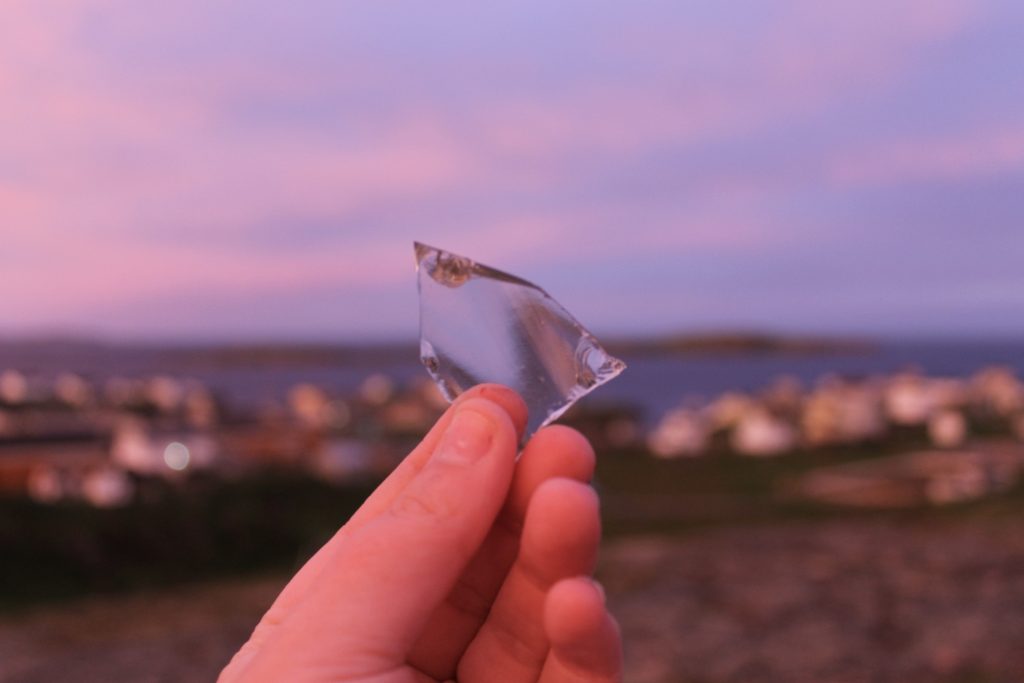

We are here,
a hopeful people with a future unclear,
divided by lines we can not see,
held back by forces that can never agree.
A language forgotten, a people ignored,
our message in bottles thrown back to our shores.
We persevere,
move with the waves as new ones appear.
As time ticks by, we dance in the sand,
bask in the freedom of isolated land.
Human and nature living as one,
creating a lifestyle that can’t be outdone.
We will thrive,
take what we’re given, and do more than survive.
A youthful beauty in those aged wooden roads
holding us high as we face our unknowns.
Covering our shorelines, seashells and glass,
telling the story of a long written past.
For amidst the rocky surround, the challenge, the time,
we have been moved, polished and shined.
We will rise,
take one step back and return with the tide.
We know who we are, and we know what that’s worth:
the yellowed grass and the muddied earth.
A path well trekked, the memories made,
even the hazardous shoals beyond the waves,
shaping us like those shards on our shores.
A discarded beauty, we are seaglass;
and we will not be ignored.
North Shore Heritage Capsules: Insights and Reflections
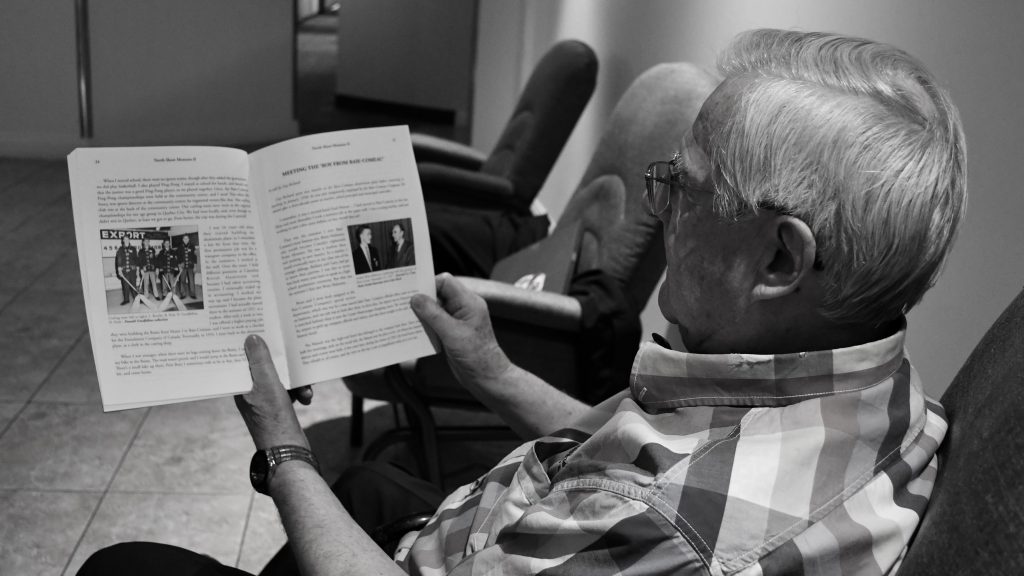
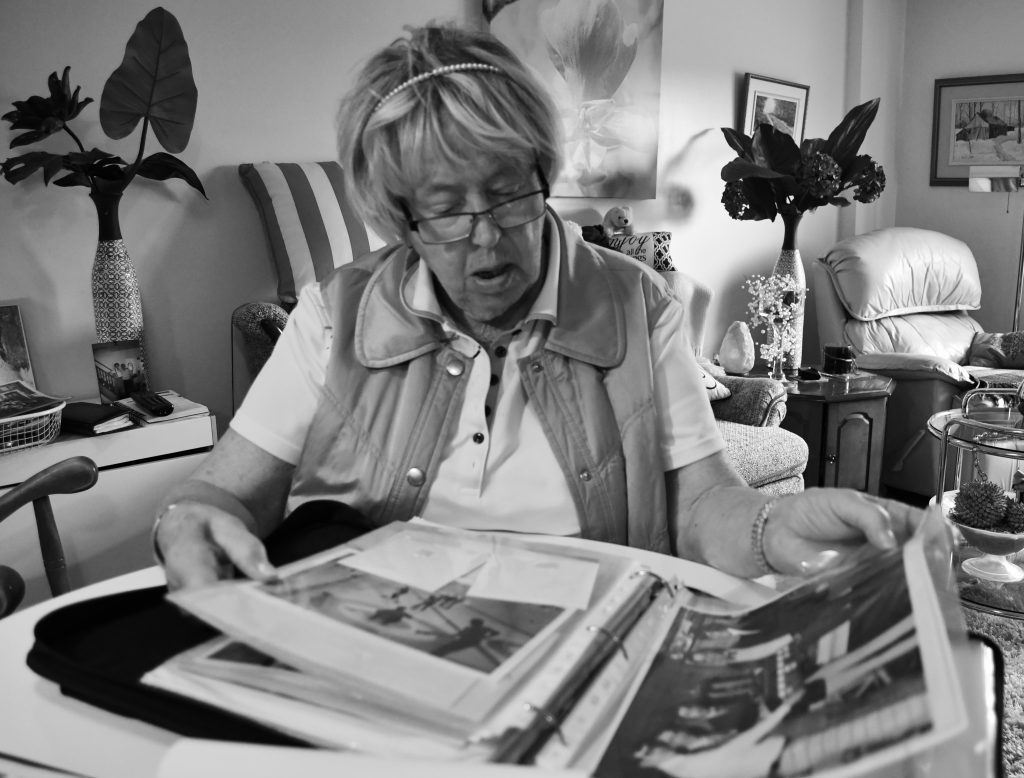


“Worth a Thousand Words: A North Shore Inter-Generational Digital Storytelling Project” represents a living history and collection of stories of bygone years in the lives of seniors from Baie-Comeau, Port-Cartier, and Sept-Îles. Over the course of eighteen months, between the fall of 2021 and winter of 2023, interviews and research were conducted to bring memories, anecdotes, and insights into a storybook-type format. The goal was to create ten to twelve digital heritage capsules that contain stories, images, and recorded voices of topics that clearly helped to define the communities.
The North Shore Community Association (NSCA) applied for and received a grant through Heritage Canada to realize this project. I was hired as their researcher, scriptwriter, and project manager. And what a wonderful experience it turned out to be!
Each community identified a variety of subjects that the English-speaking seniors wanted to showcase. Baie-Comeau focused on the Baie Comeau Community Association (BCCA), an organization and building that provided a central spot for most of its socio-cultural and recreational activities from 1938 to 1968. Port-Cartier put a spotlight on Riverview School that was the central hub for its anglophone community. Sept-Îles put their railroad, built in the early 1950s, in the limelight. In addition, there were two heritage capsules that featured the regional aspects.
I gained a number of insights while working on this project.
With this type of storytelling, the sense of urgency can never be underestimated. The stories, the first-hand accounts disappear with the passing of our seniors. Time is of the essence as people’s memories fade, photographs are lost, and people die.
The dozens and dozens of pages of notes are just as valuable as the published heritage capsules. In one example, twenty-five pages of typewritten notes for the Port-Cartier capsules had to be condensed into four scripts. The editor had to further reduce them down to about seven hundred words. Do the words and memories of those left on the “cutting floor” go to waste? In due course, they will be collated into a document that tells an even more complete story. Same goes for the photographs.
As a researcher and interviewer, it was critical that information be supported by a number of sources. Going through books, journals, and cross-referencing people’s anecdotes is important in order to ensure authenticity. There is a difference between nostalgia and memory. The history of anglophones on the North Shore is not well documented. So, it is important to verify and clarify information.
There are stories that have rarely ever been heard. It is only by taking time to listen, to ask pointed questions, and by reading images supplied by people that they can be brought to light. This last point is crucial. One must carefully look at the background, the little things that one easily misses on a first glance, and who else is in the photograph. The images tell their own stories and they can also help in triggering memories and those important details that lead into incredible insights and discoveries. This happened when I was looking through the yearbooks of Riverview School and I recognized the eyes of one person and their hometown of Saint Paul’s River (Lower North Shore). I soon realized I actually knew this person going back to the early 1990s. She was one of the 1971 graduates along with another person from her hometown. How does a person from the Lower North Shore end up in Port-Cartier rather than at the high school in Sept-Îles? Well, the stories of these two people soon came to light and were highlighted in the heritage capsules. They recount their first time experiencing indoor plumbing, restaurants, and electricity. But it was the sense of community that helped them over their four years of being billeted.
In Baie-Comeau, memories and nostalgia were intertwined as the seniors told of the socio-cultural and recreational activities at the BCCA. It was all about a community ensuring that boredom was not part of the landscape. It told of how the French and the English came together for numerous sporting activities, card parties, and dances. It tells of the first public bilingual library in Quebec led by pioneer Alice Lane. It speaks to the pride and recognition of how individuals with a strong sense of community and purpose made Baie-Comeau a vibrant town and how one place became the heartbeat of an isolated North Shore town. And these are lasting legacies.
The photos and narration, the first-hand accounts and living stories speak volumes of the respective communities and people’s passion for life, for community involvement and their ultimate gift, that of storytelling. The anglophone communities now have yet another venue for telling their unique histories and their memories of yesteryear. Take a look for yourselves. The heritage capsules are available online at: https://quebecnorthshore.org/heritage-capsules/
how does one find a way to come back so many times?


in a region
that is said to have no roads,
how does one find a way
to come back so many times?
maybe that person
creates paths aplenty,
lines in the moss,
boats on bodies of water,
trails of airplanes,
and a route blanche for harsh winters,
somewhere to lay down
the heart amongst
sea, rivers, ponds,
rocks, lichens,
redberries, bakeapples,
blackberries, Labrador tea,
on a land
where a cup of tea unveils stories,
and where being called my love is a shelter;
even if that place isn’t what you could call home.
but what is a home?
is it where you grew up?
is it where you fell in love?
is it where you wouldn’t mind dying?
is it the same time zone?
is it the same language?
is it the same culture?
or can it be
a space in you?
anywhere the breath
becomes a cabin on an island,
a whale greeting you
in the Strait of Belle Isle.
The Story of Font


Font began as an idea in early 2021 that developed into a proposal to the Canada Council’s “Digital Now” program.
This was during the pandemic, and we were all suffering one way and quite likely another. “Digital Now” had been designed to use organizations such as ours to funnel funds into the hands of early-career and emerging artists, and it offered a maximum $100,000 to be paid primarily to such artists.
The Idea.
The idea behind Font was that writers and other literary artists want not only to create new work but to see it published, out in the world. They need the validation of being published.
They also need to earn money from their work—and to be able to imagine ways of making a living in the literary arts.
April 2021. Proposal submission.
The proposal LLP prepared was for an online platform to publish the work of early-career and emerging literary artists from marginalized communities across Quebec. A handful of more experienced writers would mentor, advise, edit, publish, and promote their work. Everyone would learn in the process, and everyone would be paid.
It takes a professional publisher to offer the chance of publication. It takes a publisher to give literary artists hope that their artistic practice can develop into a sustainable career.
LLP is a publishing company specializing in literary fiction, non-fiction, and books for young people. This new digital platform, we argued, would allow LLP and other houses to publish the most compelling work of these emerging literary artists in book form, as well as in the magazine.
As part of the application, we had to provide a list of those who’d be involved and provide their resumés, job descriptions, a detailed budget, and related information about our history, our mission, and our accomplishements.
Associate publisher Leila Marshy and I conferred, then made calls to a few people we thought might be interested in a role such a publication. Poets and community activists Rachel McCrum and Deanna Radford were interested, as was Edward He, a student who had been working as a freelance editor for LLP.
By April 21st, the budget was ready.
I pressed “Submit.”
July 30, 2021. Results letter from the Canada Council.
“The assessment committee that evaluated your application recommended it for financial support. You have been awarded a grant of $100,000.”
August-October, 2021.
I took Rachel McCrum to lunch to discuss plans on August 3rd.
In the weeks that followed, LLP signed contracts with Rachel McCrum as Editor-in-Chief, with Deanna as Digital Editor and with Edward as Copy Editor, setting up payroll services for each employee, and making plans for the first issues.
Much was clear from the outset—but there were two exceptions. And one important detail we didn’t yet know.
One of the exceptions was the name of this new magazine. We came up with Font once the team was all on board.
The other was that we had not yet identified a designer for the platform. It was Deanna who knew of digital design studio house9, and Rachel who followed up with Farah Khan and her team.
We were on our way.
The November Issue 2021: Young Black Writers.
What a surprise to get a call from the Black Community Resource Centre (BCRC) early that Fall looking for a partner to publish the work of young Black writers.
What a delight to launch the inaugural issue of Font—The November Issue 2021—which features work by young Black writers—to an astonished literary milieu.
And what a joy that, as book publishers, working with BCRC, we could then publish in print a collective work by those very same young Black writers.
Where They Stood: The Evolution of the Black Anglo Community in Montreal was published by LLP in March 2022.
December 2021-December 2023.
There have been no fewer than 16 subsequent issues of Font in the 24 months between December 2021 and December 2023.
But, sad to say, this issue, the one you’re reading right now, is the last.
For the important detail we didn’t know at the outset was that our application to the Canada Council was a one-off.
It was well after the launch of Font that we learned there could be no follow-up funding from the Digital Now program, which had wrapped up.
We turned to some of our partners. The Quebec Writers’ Federation came through with support for a project building relationships with Indigenous writers in the Fall of 2022 and then sponsored the Spring 2023 issue of Font, guest-edited by Leila Marshy.
We applied to the Canada Periodical Fund’s program, Special Measures for Journalism, and got enough support to publish the Summer 2023 issue.
We applied to the CPF again, and got just enough support for the issue you’re now reading.
One of the great advantages of LLP as publisher of Font is that it is primarily a book publisher.
That is also the great disadvantages of LLP as publisher of Font.
Here’s the reason.
Book publishers optimistically operate as for-profit enterprises, even if they don’t necessarily make any profit at all.
And it just so happens that most of the support for magazines is limited to non-profit organizations.
We left no stone unturned, applied for Font under the umbrella of our CCA operating funding grant, but there was funding this year for very few new activities, and we learned some weeks ago that we’d been unsuccessful.
Over a period of months, we discussed the possibility of incorporating a new non-profit organization, but that turned out to be impractical.
So, we eventually had to face the fact that this issue would be the last.
It’s Been Grand, Font.
I’ll end on a personal note, for I started my life with magazines—my father was the editor of Medical World in London when I was a child—and I started my literary career as publisher and editor of Matrix magazine in 1989.
I’m so proud of the way Rachel, Leila, Deanna, Edward, and the house9 team rose to the occasion and turned the Font vision into a reality.
We’re all proud of Font, as you’ll see from what each has written in their envoi.
We’re proud of what it is and of how it looks, of its literary content and its visual impact.
We’re proud of its contributors, who range in age from high school students to pensioners, and from backgrounds that include inner-city immigrants as well as communities far from the metropolis.
We’re delighted by the many new partners we made across the province.
We’re grateful to our friends at the Canada Council for the Arts, the Canada Periodical Fund, and the Quebec Writers’ Federation for their invaluable support.
We’re aware, too, of the impact Font has had on how people now look at literary periodicals, for Font is not just a showcase. Gorgeous as it is, it’s also been a training ground. It’s taught nearly 150 emerging writers what it means to work with editors and proofreaders. What it means to revise and develop their work.
It’s taught them about contracts and deadlines and the editorial process and payments for their work, too. Given them a taste of professionalism, and in so many cases a taste for professionalism.
It’s let them know what a literary career might look like.
We all look forward to what comes next.
Font staff reflect
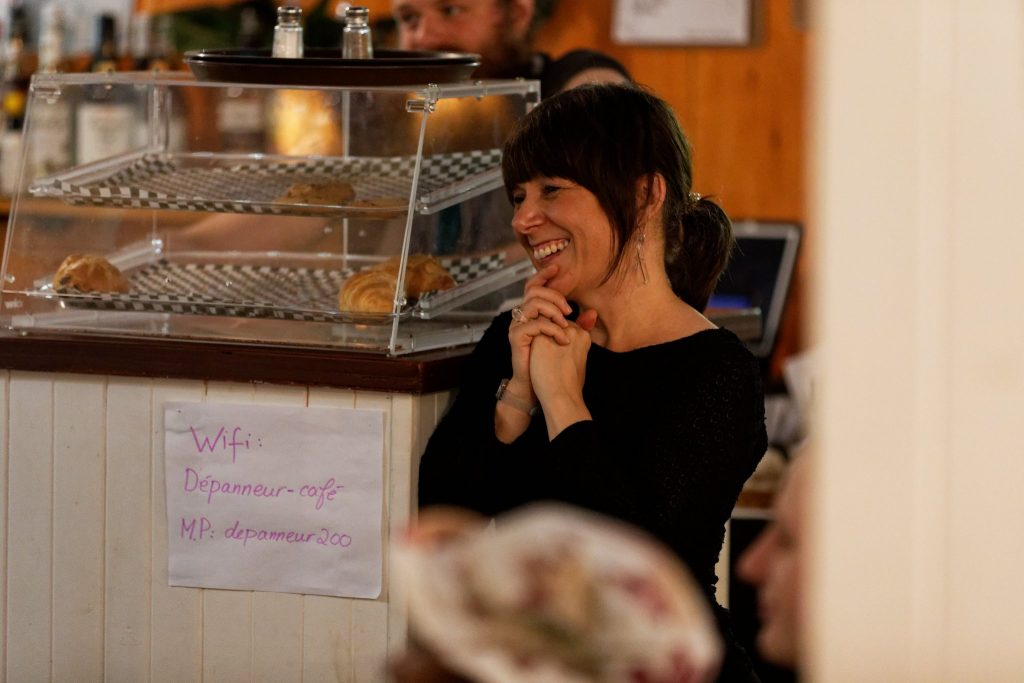

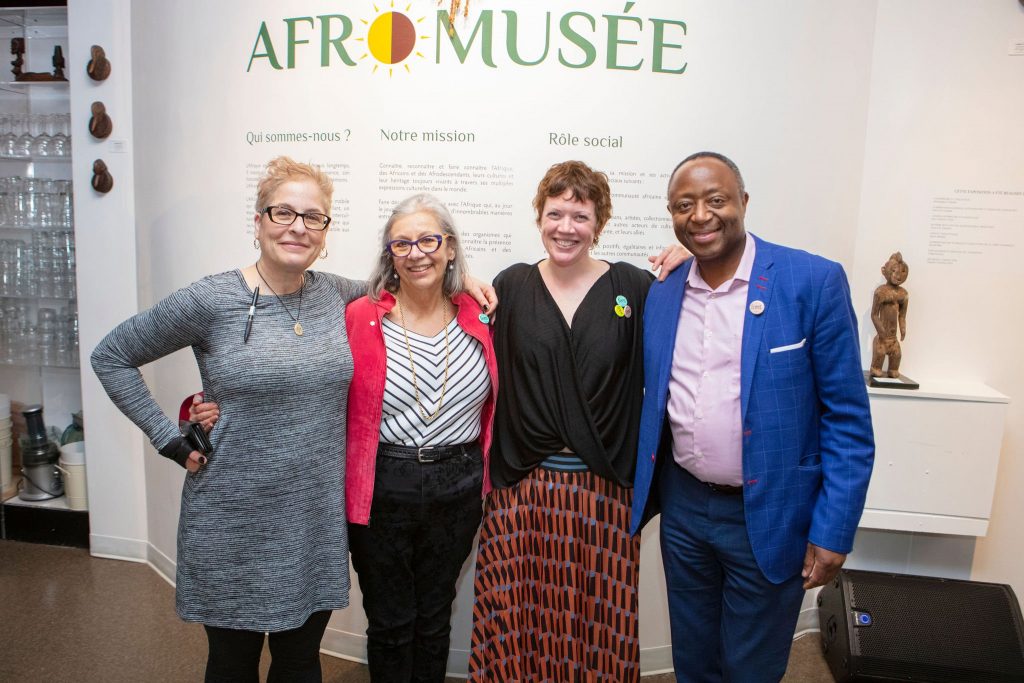

Joining Font Publisher Linda Leith and Editor in Chief Rachel McCrum late in the summer of 2021 to work on what would become Font magazine was a gift to be invigorated by, particularly as the COVID-19 pandemic was in its early stages of degrowth.
When I think about the lead-up to publishing the first issue of Font, I remember how we spoke of plans by phone across long distances, met on a café terrace to build upon our mission and mandate, and engaged with House9 about the name and identity of our new literary mag and website design and construction on Zoom. Experiences with all involved during this period of about three months still resonate as bright, generous, constructive, collaborative.
This resonance was sustained throughout my experience at Font.
Such as with the shop talk we — Rachel, Copy Editor Edward He, Editor Leila Marshy (Spring 2023) and I — engaged in to divide tasks, discuss editorial quandaries and promotion, and to share our experiences.
Such as with Issue #1 – Young Black Writers (November 2021) which featured a significant number of audio works (which also included text and images.) The recordings were impressive for qualities of production, strong writing and performance, vision, thoughtfulness. Editing these pieces hence involved not only the audio, but also text and image. We looked at framing of the works as a whole, considered how the audio and images interacted with the text, and checked how technical aspects might need to be adjusted for the publication. Each contributor rose to the occasion to clarify their contributions with an openness and conviction that moved me. My experiences with the issues of Font that followed were not unlike this one.
Coming to Font as Digital Content Editor, a lifelong music/sound/spoken word fan, and performance poet meant I could combine my obsessions with an editorial process as I hadn’t done before. It gave me a chance to implement editorial practices that I care about — such as writing well-thought image alt-text for user friendliness (a learning process!) and accessibility needs of blind internet users, and providing resources to contributors for finding stock images by ethical producers interested in expanding the scope of visual representation online away from racist, gendered, sexist, ableist, ageist tropes.
It was a great privilege to work on the Font team and with its contributors from Montreal and across Quebec; to help establish a trusted site for new and early career writers working in English in all of their multiplicities. While this chapter of Font may be complete, I hope that the literature it holds and the writers who authored work here continue and grow. There is so much more work of the imagination that needs to be done urgently, to be shared, and supported at this moment in time and perhaps, as always.
Deanna Radford, Digital Media Editor

For me, it all began with that tentative internship request I sent to Linda Leith in 2021. I had very little experience in publishing, but was lucky enough to have been given an opportunity. A few editing assignments and months of correspondence later, she told me of LLP’s plans to launch a new publication: Font magazine.
At first, I was anxious. I had yet to complete my Bachelor in English, and felt out of place working as the copy editor alongside seasoned professionals like Rachel McCrum and Deanna Radford. But after the first meeting, we knew there was a common vision: of Font as an indie film competing against Hollywood blockbusters.
We followed our mission statement closely, showcasing compelling underrepresented literary activity from across Quebec. It brought us from Montreal’s Black Community Resource Centre all the way to Studio Georgeville in the Eastern Townships, and then to Quebec City’s Morrin Centre, plus many more places.
It was an enriching experience to witness the literary effervescence in the works of writers from various communities. But the most memorable event was the launch party in June 2022. It was the first time I met Rachel and Deanna in person, and they were kind enough to remember my upcoming graduation. With my thesis defence looming, their congratulatory words and that bottle of cider were much appreciated.
Unfortunately, this will be Font’s last issue. These are bittersweet words, but all things begin and end. During these two years, a lot has changed for me. I started working at a bank and then moved to another continent. I’ve learned a lot working alongside my wonderful colleagues, and I’m sure the best is yet to come. Linda, Rachel, and Deanna have been nothing but encouraging and supportive, even when I stumbled. For this, I thank them.
Edward He, Copy Editor

25 months. 17 Issues. 135 authors. 137 articles.
Oh, Font. It has been such a pleasure and a privilege to serve as your Editor in Chief.
I am so proud of every Issue, of every article, of every contributor. Each month (and it was on a fairly intense monthly repeat for the first 14 issues), I would find myself grinning at the wealth of writing talent to be found in every corner of Quebec.
That the Quebec that we were representing was – is – multi-lingual, observant, reflective, and generous.
That there is so much to discover outside Montreal, and IN Montreal: the Young Adult authors festival at the Jewish Public Library, the Black Community Resource Centre, Teesri Duniya Theatre Company.
That we had the freedom to be playful with ideas of writing and literature beyond simple written prose or poetry: to include song, image, film.
That we could talk to literature teachers across the province, who are so essential to cultivating a love of words in young people, and who so rarely get to speak publicly for themselves, and to the radical and independent journalists working tirelessly to publish truth in a chaotic media world.
It’s not really possible nor fair to pick favourites – I truly do mean the pride and joy I have in every single Issue – so I’ll close my eyes and think quickly of moments that stood out for me.
To witness the debate between the contributors around Issue #6 – SWANA Voices – as we were educated that ‘South West Asian and North African’ is much preferable to the colonial throwback of ‘Middle Eastern’. To be able to publish in Arabic in the same Issue, and to share the sheer diversity of Arabic voices and writers living and writing in Quebec, from Amazigh, Egyptian, Palestinian, Lebanese and Iranian backgrounds; female, femme, and queer.
To be able to share Andrée Levesque Sioui’s song in the endangered Indigenous language of Wendat, and to talk to Louis-Karl Picard-Sioui about the growth of the Salon du livre des Premières Nations.
To invite workshop facilitators Deanna Smith, Dona Nham, and Barbara Burgess to nurture new writers across the province. To pay everyone.
To be gently schooled in the needs of the Unruly Writers, and learning to adjust our (my) ideas of occasionally too-tight deadlines accordingly.
To question, constantly, with the editorial team, if we are doing justice to the individual writer’s voice, rather than blanketing a uniform style guide over it all.
To develop mutually supportive relationships with cultural and literary organisations across the province: the Morrin Centre, the Reford Gardens, Studio Georgeville, Heritage Lower Saint Lawrence, the Black Community Resource Centre, Quebec Writers’ Federation. My special thanks also to Elspeth Tulloch at Université Laval for her initiative and support for our two Quebec-based Issues.
These are many moments.
I find myself, inevitably, thinking of the Issues that we didn’t get to publish. The communities that we ran out of time to connect with; the areas of this vast province that we didn’t get to explore; the languages that we didn’t hear; the voices that we didn’t amplify. There was an Issue with the Chinese community of Montreal that remained a dream; a curiosity about the English-language artistic community around Wakefield in Outaouais; the vast North, and everything that could be said about that.
Had Font continued, I think that the next stage would have been to offer opportunities – paid, of course – to more guest Editors.
I believe that true diversity comes from decentering power and dismantling hierarchy, and while the editorial team aimed to be as open, flexible, and humble as possible when working with different voices, it would have been magnificent to be able to invite members of the various communities themselves to take on editorial and curatorial roles. We had a taste of this with Métis guest editor Willie Poll for Issue 14 – Indigenous Power: Past, Present, and Future. How marvelous it would have been to be able to share the decision-making and the power around, while continuing to provide the platform and structural support.
To the team, my deepest thanks. It has been such a joy to work with you all, and I will miss you. Linda, you are quite simply an icon, and I have been constantly inspired by your curiosity, your rigour, and your warmth. Deanna, for your meticulousness, your clever insight, and your unceasing care. Edward, for your incredibly fast and thorough editing, your willingness to discuss many of the finer points of ‘voice’, and your unexpected pop-culture references. To Farah and the house9 crew, you rock. To the contributors, and to you, the Font readers – thank you.
It has been a pleasure.
Rachel McCrum, Editor in Chief